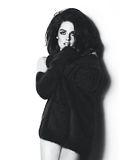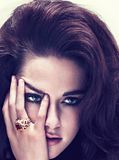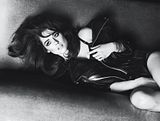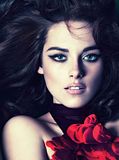change 320p to 720p to view it in HD
W Magazine WOMAN ON THE VERGE
TWILIGHT’S KRISTEN STEWART ON GROWING UP, GETTING MARRIED, AND GIVING BIRTH—AS MILLIONS LOOK ON. By Lynn Hirschberg
September 2011
Lynn Hirschberg: Everyone knows you as Bella Swan, the heroine of the Twilight series, whose penultimate installment, Breaking Dawn Part 1, premieres on November 18. What audiences may not know is that you’ve been acting since you were a child. How did you get your start?
Kristen Stewart: It’s weird, because I would be the last person in my school to be in plays, but I was forced to sing a song in a school thing. I sang a dreidl song, which is funny for me. I’ve never celebrated Hanukkah—it wasn’t in my upbringing, but it was one of those deals where everybody has to pick a song or participate somehow in the chorus. It wasn’t the normal dreidl song; I can’t really remember the words, but it was a more serious dreidl song. The dreidl was huge, it was really honored. And that’s how I met my agent, who was in the audience. I was eight. I was nine when I did my first movie, The Safety of Objects.
More after the JUMP!
Did you do any commercials, or did you go straight into films?
I did two commercials, one for Porsche, but I was definitely not the type of child one would cast in a commercial or any TV that you’d typically go out for as a young kid. I wasn’t the type of kid who would be in stuff that kids watch. I wasn’t cutesy.
In 1999 David Fincher cast you as Jodie Foster’s daughter in Panic Room. He likes to do dozens of takes for each scene. Was that difficult, as a child?
I didn’t realize that 80 takes wasn’t normal. But it’s funny: Some of my proudest moments from film sets are in Panic Room. My character had seizures. Just being able to say, I was 10 years old and I broke all the blood vessels in my eye on that take, is cool. It was fun.
You had a tomboy quality, which was unusual.
I have brothers, and that so-called boyish quality was something that I was deathly self-conscious about when I was younger. I was, like, No, I’m a girl. Actually, I’m still embarrassed to say that.
But it sets you apart from other young actresses. And it made you more interesting.
I don’t really know what to say. I just knew I wanted to work. And I did. I was working when I read the script for Twilight. I read the script before I read the book. I actually did the audition before reading the book, which was kind of crazy. Obviously, I tore all four books apart over the course of three years, but initially I had no idea that Twilight was such a big deal.
Did you have a particular interest in vampires? All young girls like vampires.
I fucking love me a vampire [Laughs]. I was 17 when I read Twilight, and at the time it was so perfect for me. The script was about young kids who think they can handle stuff that they just can’t. And they’re going to do it anyway. Because, why not? Just torture yourself. I relate to that. Vampires are a little dangerous—and we girls like to test ourselves.
In Breaking Dawn, Bella and Edward, her beloved vampire, get married. What was the wedding like?
Awesome. This was my first wedding. It was insane. And odd. The wedding dress experience was a huge deal. I tried on one version of the dress, and it was like tweak and tweak and alter and tweak and change, and then it’s done. BFD dress. Huge deal.
How was the actual wedding?
It was major. The last Twilight book is filled with BFDs, things that people have been waiting for for so long. For me, it was ridiculously dramatic: I get married, give birth, the baby has an incredibly accelerated growth rate we’re all very concerned about, and I say goodbye to my dad for the last time ever. It was all big—I could never go, Whew, I’m losing this character.
Did you finally say goodbye to Bella in some meaningful way? You’ve been living with her for a long time.
I’d been anticipating that end-of-Bella moment. I was going, Oh, my God—I wonder how I’m going to feel. And the last scene of the shoot was at the wedding. Every single character was there on set. At the end of that day, I was kind of whacked. And so I never really had that moment then. Instead, it happened later. We needed to film one more sort of honeymoon scene and we went to the Virgin Islands. After that scene, my true final scene, I felt like I could shoot up into the night sky and every pore of my body would shoot light. I felt lighter than I’ve ever felt in my life.
Twilight was your college, and you graduated, in a way: You became Bella Swan at 17, and now you’re 21.
Yeah—and that time has been sort of nuts for me. In film, I have chronicled every stage of my life since I was nine. And it’s more intense now, obviously, because I’m not in control of it anymore.
You’re not in charge of your life?
No. Not really. Not if I want to think solely about what I really like to do. It’s a funny thing: You want so badly for people to see what you do—you’re proud of it—and I like the effect that movies have on people. But the attention can also make me uncomfortable. In certain situations, people say to me, “C’mon, what’s wrong with you?” I apologize. I love what I’m doing, but I’m a little uncomfortable.
Do you like watching yourself?
It’s not like I sit around watching my movies again and again, but I’ve never quite believed actors when they say they don’t watch themselves. I hear them going around the block to make excuses for why they don’t watch their work. It’s bullshit. Sorry, guys—I know you watch your stuff.
It must be interesting to watch your younger self in movies. Very few people have such an extensive visual record of themselves at so many ages.
I get embarrassed. It’s weird, too: I’m 10 years old in Panic Room, and that’s a version of myself that’s pretty far away, but it doesn’t feel that far away to me. Occasionally my dad will flip the TV on, and it’s cool to look at some movie that I’m in for one second. And then, “Dude, off. Now. Like, cut it out.”
About the cover. Kristen Stewart on W's September 2011 cover.
Hair by Luigi Murenu for John Frieda; makeup by Lucia Pieroni for Clé de Peau Beauté; manicure by Lorraine Griffin for Chanel. Fashion: Max Mara’s mohair and wool sweater.
Beauty: Dior Forever Flawless Perfection Fusion Wear Makeup in Light Beige; Diorblush in Vintage Pink; Diorshow Brow Styler in Universal Brown; 1-Couleur Eyeshadow in Argentic; Crayon Khôl in Black; Rouge Dior lipstick in Angélique Beige.
Photographs by Mert Alas & Marcus Piggott
Styled by Edward Enninful
via Robstenation






No comments:
Post a Comment
Please comment respectfully and don't include any links or phone numbers.